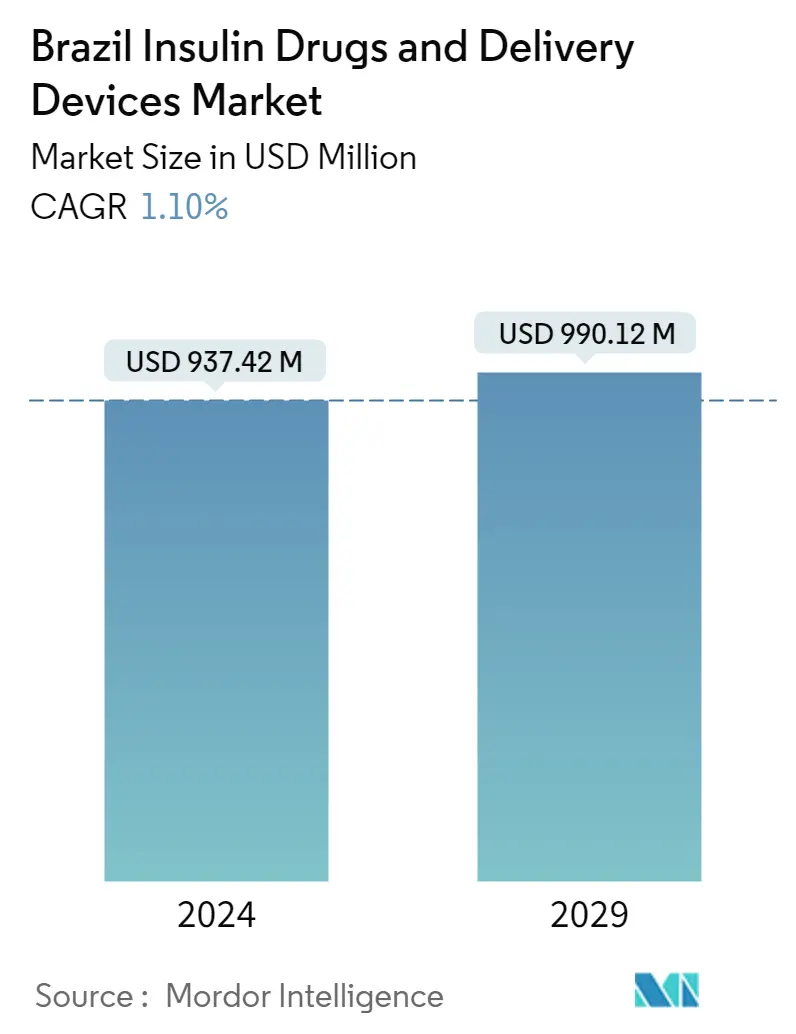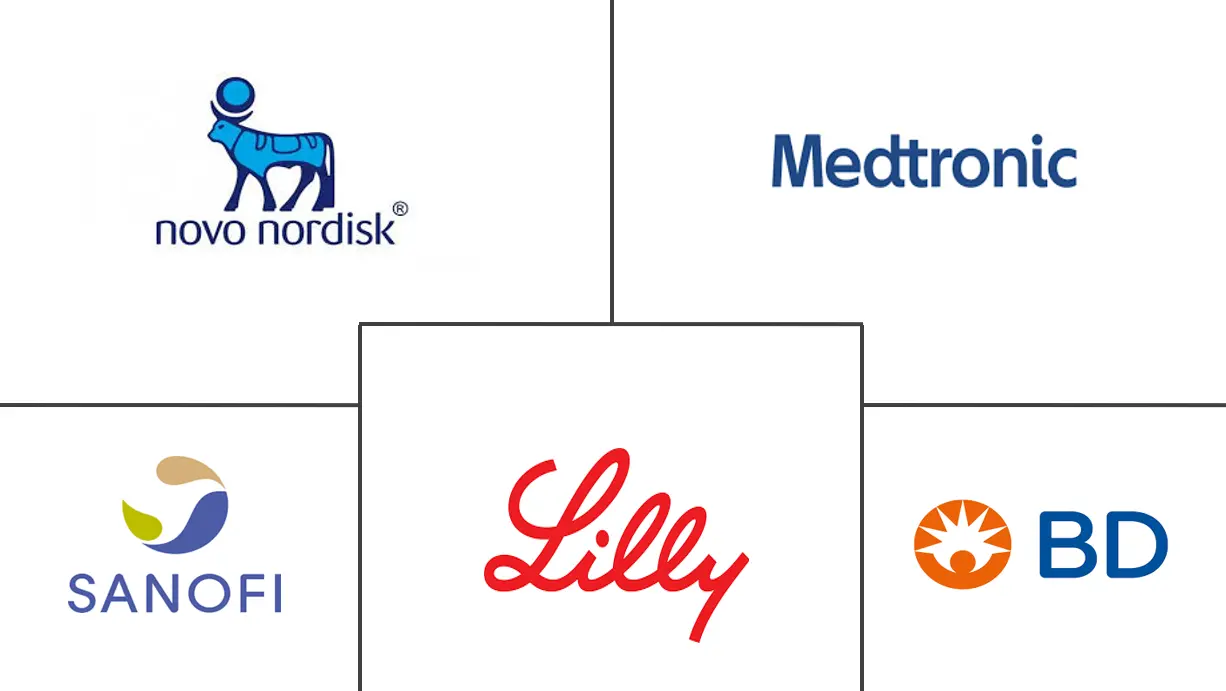Market Size of Brazil Insulin Drugs & Delivery Devices Industry

| Study Period | 2018 - 2029 |
| Base Year For Estimation | 2023 |
| Forecast Data Period | 2024 - 2029 |
| Market Size (2024) | USD 937.42 Million |
| Market Size (2029) | USD 990.12 Million |
| CAGR (2024 - 2029) | 1.10 % |
Major Players
*Disclaimer: Major Players sorted in no particular order |
Brazil Insulin Drugs & Delivery Devices Market Analysis
The Brazil Insulin Drugs & Delivery Devices Market size is estimated at USD 937.42 million in 2024, and is expected to reach USD 990.12 million by 2029, growing at a CAGR of 1.10% during the forecast period (2024-2029).
Diabetes is a chronic condition demanding self-management and care, which involves regular attention to food, physical activity, blood sugar monitoring, and the use of medications. People with chronic diseases such as diabetes mellitus and obesity have a worse prognosis of COVID-19. Diabetic people are twice as likely to have their comorbid conditions worsened and consequently die. The healthcare system must be better organized for more severe cases of COVID-19 as studies suggest that inadequate glycemic control increases the risk of undesired outcomes in diabetic patients with SARS-CoV-2 infection. The prevalence of diabetes in people hospitalized with COVID-19 infection and the recognition that improved glycemic control might improve outcomes and reduce the length of stay in patients with COVID-19 have underlined the importance of diabetes care.
Diabetes is associated with many health complications. Comparing the population with and without diabetes, those with diabetes have a 300% increased risk of being hospitalized and, thus, incur more healthcare expenses compared to non-diabetic people. People with diabetes face a higher chance of experiencing serious complications from COVID-19. In general, people with diabetes are more likely to experience severe symptoms and complications when infected with a virus. Diabetes and high glucose levels are associated with increased complications, respiratory failure, and mortality in hospitalized patients with coronavirus.
Brazil has implemented a set of reforms over the past to improve the distribution of doctors, develop new forms of the service organization, introduce new financing models, and implement a range of quality improvement initiatives and policy frameworks to overcome risk factors such as obesity and emerging pandemic threats. The pandemic also highlighted opportunities for continuing and expanding innovations in the delivery of diabetes care, through virtual consultations between healthcare providers and people with diabetes, and the use of diabetes technology. Thus, the COVID-19 outbreak increased the insulin market's growth.
Brazil Insulin Drugs & Delivery Devices Industry Segmentation
Insulin is mainly used to treat type 1 diabetes but can be used in people with type 2 diabetes if insulin levels remain low despite using other medications. There are different ways to inject insulin into a patient's body, using syringes, pens, pumps, and jet injectors, giving them various options for insulin delivery. The Brazil Insulin Drugs and Delivery Devices Market is segmented into Drugs (Basal or Long-acting insulins, Bolus or Fast-acting insulins, traditional human insulins, combination insulins, and biosimilar insulins) and devices (insulin pens, insulin pumps, insulin syringes, and jet injectors). The report offers the value (in USD million) and volume (in a million mL) for insulin drugs and (in unit million) for the devices for the above segments.
| Drug | |||||||
| |||||||
| |||||||
| |||||||
| |||||||
|
| Device | |||||
| |||||
| |||||
| Insulin Syringes | |||||
| Insulin Jet Injectors |
Brazil Insulin Drugs & Delivery Devices Market Size Summary
The insulin drugs and delivery devices market in Brazil is poised for growth, driven by the increasing prevalence of diabetes and the need for effective management solutions. Diabetes, a chronic condition requiring diligent self-care, has been exacerbated by the COVID-19 pandemic, highlighting the importance of glycemic control to improve patient outcomes. The Brazilian healthcare system has been actively reforming to enhance diabetes care, including the adoption of virtual consultations and advanced diabetes technologies. Despite these efforts, a significant portion of the diabetic population remains undiagnosed, and many do not achieve optimal glycemic control, contributing to the economic burden of the disease. The market is characterized by a high demand for insulin delivery devices, particularly disposable insulin pens, which offer convenience and ease of use for patients.
The Brazilian market for insulin drugs and delivery devices is moderately consolidated, with key players like Novo Nordisk, Eli Lilly, and Sanofi leading the charge. These companies have engaged in strategic collaborations and mergers to strengthen their market presence and enhance product offerings. The Federal Government's partnership with private companies to streamline the supply chain has further facilitated the adoption of insulin devices at competitive prices. Innovations such as smart insulin pens and oral insulin capsules are expected to revolutionize diabetes management in Brazil. As the diabetic population continues to grow, the market is anticipated to expand, supported by ongoing advancements in insulin therapy and delivery mechanisms.
Brazil Insulin Drugs & Delivery Devices Market Size - Table of Contents
-
1. MARKET DYNAMICS
-
1.1 Market Overview
-
1.2 Market Drivers
-
1.3 Market Restraints
-
1.4 Porter's Five Forces Analysis
-
1.4.1 Bargaining Power of Suppliers
-
1.4.2 Bargaining Power of Consumers
-
1.4.3 Threat of New Entrants
-
1.4.4 Threat of Substitute Products and Services
-
1.4.5 Intensity of Competitive Rivalry
-
-
-
2. MARKET SEGMENTATION
-
2.1 Drug
-
2.1.1 Basal or Long-acting Insulins
-
2.1.1.1 Lantus (Insulin Glargine)
-
2.1.1.2 Levemir (Insulin Detemir)
-
2.1.1.3 Toujeo (Insulin Glargine)
-
2.1.1.4 Tresiba (Insulin Degludec)
-
2.1.1.5 Basaglar (Insulin Glargine)
-
-
2.1.2 Bolus or Fast-acting Insulins
-
2.1.2.1 NovoRapid/Novolog (Insulin aspart)
-
2.1.2.2 Humalog (Insulin lispro)
-
2.1.2.3 Apidra (Insulin glulisine)
-
2.1.2.4 FIASP (Insulin aspart)
-
2.1.2.5 Admelog (Insulin lispro Sanofi)
-
-
2.1.3 Traditional Human Insulins
-
2.1.3.1 Novolin/Mixtard/Actrapid/Insulatard
-
2.1.3.2 Humulin
-
2.1.3.3 Insuman
-
-
2.1.4 Combination Insulins
-
2.1.4.1 NovoMix (Biphasic Insulin aspart)
-
2.1.4.2 Ryzodeg (Insulin degludec and Insulin aspart)
-
2.1.4.3 Xultophy (Insulin degludec and Liraglutide)
-
2.1.4.4 Soliqua/Suliqua (Insulin glargine and Lixisenatide)
-
-
2.1.5 Biosimilar Insulins
-
2.1.5.1 Insulin Glargine Biosimilars
-
2.1.5.2 Human Insulin Biosimilars
-
-
-
2.2 Device
-
2.2.1 Insulin Pens
-
2.2.1.1 Cartridges in reusable pens
-
2.2.1.2 Disposable insulin pens
-
-
2.2.2 Insulin Pumps
-
2.2.2.1 Insulin Pump Devices
-
2.2.2.2 Insulin Pump Reservoirs
-
2.2.2.3 Insulin Infusion sets
-
-
2.2.3 Insulin Syringes
-
2.2.4 Insulin Jet Injectors
-
-
Brazil Insulin Drugs & Delivery Devices Market Size FAQs
How big is the Brazil Insulin Drugs & Delivery Devices Market?
The Brazil Insulin Drugs & Delivery Devices Market size is expected to reach USD 937.42 million in 2024 and grow at a CAGR of 1.10% to reach USD 990.12 million by 2029.
What is the current Brazil Insulin Drugs & Delivery Devices Market size?
In 2024, the Brazil Insulin Drugs & Delivery Devices Market size is expected to reach USD 937.42 million.

